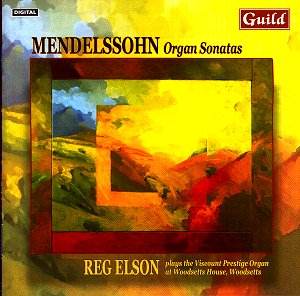The first question is what exactly is a Viscount
Prestige organ? You might be forgiven if at first you thought
it some kind of kitchen utensil or domestic appliance, but it
is in fact an electronic organ which sits in the private dwelling
of the performer Reg Elson.
You may well ask how it is that Mendelssohnís
great, indeed sometimes massive organ sonatas find themselves
on this instrument and what it is like.
Guild have, as ever, helped us by providing an
essay written about the instrument by Reg Elson with a useful
résumé of each movement of each sonata and even
more usefully a complete organ specification. Impressive it is
too. The recording location is the clue, Woodsetts House, not
a church.
The organ is a 3-manual instrument with a simulated
tracker action and drawstops! Reg goes on to tell us that "the
Viscount has been sitting happily in my home for the last twelve
months and is voiced using various samples from North German organs".
Perhaps it was for this reason that he chose Mendelssohnís sonatas
to record when possibly baroque or earlier music might have been
more suitable. The advantage Reg tells us is that organ music
can often be spoiled by the acoustic, meaning that some musical
detail can be lost. I know this for myself when my own Organ Sonata
was performed brilliantly at York Minster without the audience
Ďhearingí more than 50% of the piece.
With the Viscount "the pipework, the building
and every rank recorded is stored in digital form which retains
the natural qualities of the pipe organ and its environment".
To see the picture on the back of the booklet you would think
that Reg Elson is sitting at any organ in a large church.
So what does it sound like and is it effective
in this repertoire?
If Mendelssohn was not now known as a great composer
he would still have been remembered for his rediscovery, of J.S.
Bach. Mendelssohnís fascination and interest manifested itself
in various areas. Sometimes it can be difficult to distinguish
between Mendelssohnís and J.S.ís Motets, large-scale choral works
and fugues. The first sonata opens with a fugue as does the third;
the sixth culminates in one. What is interesting is that the fugal
subjects and counter subjects are always clear with this organ
and the counterpoint never stodgy or indistinct. Whilst the bass
weight does not seem to be lost, the upper registers on the ĎGreatí
are not so impressive and they fail, to my ear, to penetrate with
requisite power. I must add however that contrary to many, I would
not view these sonatas as unduly heavy or weighty. None is particularly
long. Number six is just over sixteen minutes. Many movements,
for example the third movement of the fourth sonata, are nothing
more or less than a song without words accompanied by a gentle
rolling pianistic figure. This organ helps to bring out almost
a chamber quality in this music where it is most appropriate.
The use of chorales is another significant stylistic
feature although sometimes, as in the finale of the Sixth Sonata
they end up being quite romantic; very much in the language so
influential and so beloved of hundreds of Victorian church musicians.
The louder music is impressive; the lyrical music
delightful. The chorale-like homophonic movements like the second
(and last) of the Second Sonata make the organ (and Iím sorry
if I upset anyone), sound as if it stuck up the corner of the
local crematorium. It is a sound I find almost ínaffí.
Written in a very short period, these sonatas
are not great Mendelssohn but there are some very attractive ideas
and they are a real pleasure to play. My favourite is the brief
three-movement fifth. The best is probably the sixth which happens
to be the longest. Reg Elson plays them with care, love and seems
to me to judge the tempi ideally with excellent choice of stops
and colour.
If you donít mind the organ and if the music
sounds interesting to you then you will enjoy these performances.
Gary Higginson
see also review
by Paul Shoemaker
